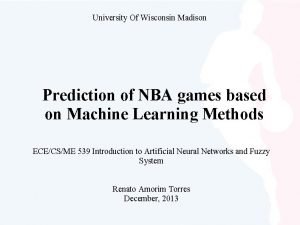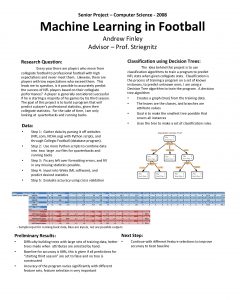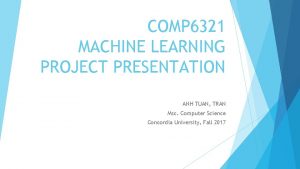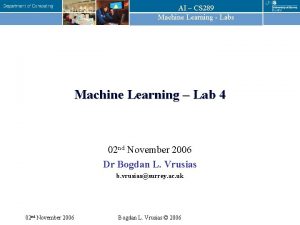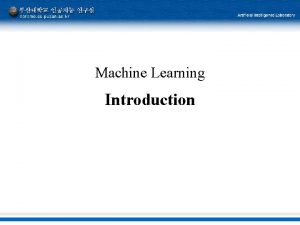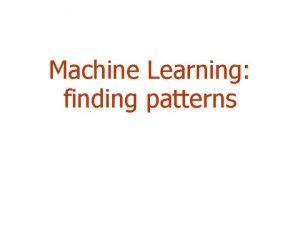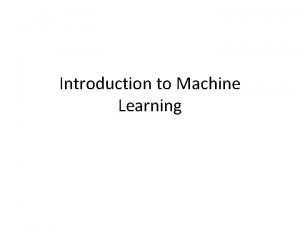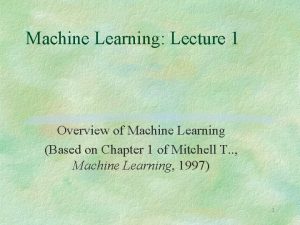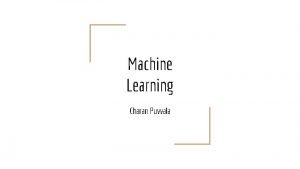Machine Learning Project PM 2 5 Prediction Disclaimer

























- Slides: 25

Machine Learning Project PM 2. 5 Prediction Disclaimer: This PPT is modified based on Dr. Hung-yi Lee http: //speech. ee. ntu. edu. tw/~tlkagk/courses_ML 17. html

Outline ❖ ❖ ❖ Project Introduction train/test data Objective for this project


Task - Predict PM 2. 5 1) Real world Data downloaded. 2) To do: Use Linear Regression to predict PM 2. 5 value.

Data Introduction ❖ Original data was divided into train set and test set. Train set is the first 20 days' data。Then test set is the leftover from the original data. ❖ train. csv:First 20 days’ data for each month in a year. [total of 240 days] ❖ test_X. csv:From the leftover of 125 days: extract every 10 hours’ data as one data-batch. Every first 9 hours’ observed feature is used to predict the 10 th hour’s PM 2. 5 value. A total of 240 non-overlapped data batch was extracted as test data,To do: predicted the PM 2. 5 value for the 240 data batches in test set.

Training Data

Testing Data

Submission format ❖ Predict the PM 2. 5 for 240 data points in test set 。 ➢ Format: csv ➢ First line must be: id, value ➢ Second line: Every row is the id and predicted PM 2. 5 value.

Instruction ❖ Python ❖ Implement linear regression,with Adagrad Gradient Descent。 ❖ Can NOT use the linear regression function from Python packages,but you are allowed to use numpy、scipy and pandas。 ( Standard library is allowed ) (numpy. linalg. lstsq is not allowed!!!)

Three Steps for Machine Learning ● ● ● Step 1. Define you function set (Model) Implement models for two different features Use all features from the first 9 hours (add bias) Use only PM 2. 5 feature from the first 9 hours (add bias) Note: a. Set NR as 0,No actions for the rest features ● b. use gradient descent ● c. Use MSE as your loss.

First 20 days monthly Rest 10 days monthly Process for


Project Implementation Instruction

Outline Simple linear regression using gradient descent (with adagrad) 1. How to extract feature 2. Implement linear regression 3. Apply model from Step (2) to predict pm 2. 5

How to extract feature (train. csv) 24 18 2014/1/1 18 2014/1/2 18 2014/1/3. . .

How to extract feature (train. csv) (Pseudo code) 1. Make one 18 -dimension vector (Data) 2. for i_th row in training data : 3. Data[i_th row%18]. append(every element in i_th row) 4. (make NR in RAINFALL->set as 0) Data will become a vector as: 2014/1/1 2014/1/2 2014/1/3 . . .

How to extract feature (train. csv) 480 18 480 January data February data Every 10 hours for one data batch 18 …. . . 480 March data …. . .

How to extract feature (train. csv) (Pseudo code) 1. Make train_x store the first 9 hours’ data, and train_y as the pm 2. 5 value at the 10 th hour 2. for i =1 st month、2 nd month. . . 3. continuously extract every consecutive 10 hours’ data: 4. train_x. append(first 9 hours’ data) 5. train_y. append(10 th hour’s pm 2. 5 value) 6. add bias to train_x

Implement linear regression –gradient descent (Pseudo code) 1. Make weight vector、initiate learning rate、# of iteration 2. for i_th iteration : 3. y’ = inner product of train_x & weight vector 4. L = y’ - train_y 5. gra = 2*np. dot( (train_x)’ , L ) 6. weight vector -= learning rate * gra

2. for i_th iteration : 3. y’ = inner product of train_x & weight vector 4. L = y’ - train_y 5. gra = 2*np. dot( (train_x)T , L ) 6. weight vector -= learning rate * gra 3. 4. L = 5. gra = 2 * p-dim vector Implement linear regression –gradient descent

Adagrad

Implement linear regression –Adagradient descent (Pseudo code) 1. Make weight vector、initiate learning rate、# of iteration Make prev_gra store the gradient for each iteration 2. for i_th iteration : 3. y’ = inner product of train_x & weight vector 4. L = y’ - train_y 5. gra = 2*np. dot( (train_x)’ , L ) prev_gra += gra**2 ada = np. sqrt(prev_gra) 6. weight vector -= learning rate * gra / ada

Predict PM 2. 5 (Pseudo code) 1. read test_x. csv 2. every 18 rows : 3. test_x. append([1]) 4. test_x. append(data for 9 hours) 5. test_y = np. dot( weight vector, test_x)

STT 512 FALL 2017 CHAPTER 2 DR. YISHI WANG 24

PREDICTION WITH MATRIX NOTATION • 25
 On formalizing fairness in prediction with machine learning
On formalizing fairness in prediction with machine learning Machine learning algorithms for restaurants
Machine learning algorithms for restaurants Stealing machine learning models via prediction apis
Stealing machine learning models via prediction apis Prediction of nba games based on machine learning methods
Prediction of nba games based on machine learning methods Stealing machine learning models via prediction apis
Stealing machine learning models via prediction apis Weisfeiler-lehman neural machine for link prediction
Weisfeiler-lehman neural machine for link prediction Concept learning task in machine learning
Concept learning task in machine learning Analytical learning in machine learning
Analytical learning in machine learning Pac learning model in machine learning
Pac learning model in machine learning Pac learning model in machine learning
Pac learning model in machine learning Inductive vs analytical learning
Inductive vs analytical learning Difference between inductive and analytical learning
Difference between inductive and analytical learning Instance based learning in machine learning
Instance based learning in machine learning Inductive learning machine learning
Inductive learning machine learning First order rule learning in machine learning
First order rule learning in machine learning Eager vs lazy classification
Eager vs lazy classification Deep learning vs machine learning
Deep learning vs machine learning Machine learning senior project ideas
Machine learning senior project ideas Comp 6321
Comp 6321 Cuadro comparativo e-learning m-learning b-learning
Cuadro comparativo e-learning m-learning b-learning Finite state machine vending machine example
Finite state machine vending machine example Moore and mealy machine
Moore and mealy machine Moore machine to mealy machine
Moore machine to mealy machine Chapter 10 energy, work and simple machines answer key
Chapter 10 energy, work and simple machines answer key What does adverb mean
What does adverb mean Championship branch prediction
Championship branch prediction



